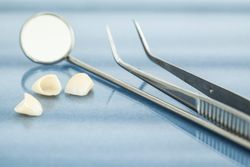
If you’ve recently had a root canal or have a tooth that’s broken, cracked, or decayed, your dentist might suggest installing a dental crown to restore the tooth’s shape and structural integrity. Dental crowns are the most commonly performed restorative dentistry procedure, and the process is surprisingly straightforward and virtually pain-free. Below, learn what this beneficial dental procedure entails.
What Are Dental Crowns?
A dental crown fits over the top of your tooth and protects it from damage. It’s cemented in place and generally lasts between five and 15 years, depending on wear and tear and your long-term brushing habits. They’re typically made from ceramic, porcelain, metal, resin, or a combination of these materials. Your dentist will choose an appropriate type based on your needs and the color of your surrounding teeth. With the right application, no one will be able to tell the difference between a dental crown and your natural teeth. The shade and shape will match your smile perfectly.
How Are Dental Crowns Placed?
 To install a dental crown, the dentist will first administer an anesthetic to desensitize the area. If you have any decay, they’ll remove the damaged portions of the tooth and sterilize the area. Then, the dentist will use a dental drill and an abrasive bur fixture to remove the top layer of the enamel and create the right texture for adhering dental cement to the tooth’s surface.
To install a dental crown, the dentist will first administer an anesthetic to desensitize the area. If you have any decay, they’ll remove the damaged portions of the tooth and sterilize the area. Then, the dentist will use a dental drill and an abrasive bur fixture to remove the top layer of the enamel and create the right texture for adhering dental cement to the tooth’s surface.
Next, they’ll use a clay-like putty or a digital scanner to make an impression of the tooth that they can send to a dental laboratory. The lab will need approximately two to three weeks to create the crown, but in the meantime, your dentist will probably install a temporary prosthetic to shield the affected tooth.
Once the lab delivers the crown, the dentist will see you for a second and final appointment. At this point, they’ll remove the temporary crown and position the permanent fixture. The dentist will ensure you’re comfortable with the fit and bite alignment, and then they’ll cement the new crown into place and cure the cement.
How Should You Care for Your Crown?
Dental crowns are extremely easy to care for. All you need to do is treat them as you would a natural tooth. Brush at least twice a day, floss daily, and see your dentist every six months for cleanings. Your dentist might also recommend avoiding certain hard foods, like ice or corn on the cob, which could displace your dental crown.
If you need restorative dentistry services, make an appointment with James Julien, DDS, in Kenai, AK. Dr. Julien can perform dental crown placements, fillings, dental bridges, and implants, in addition to routine cleanings and oral exams. The team at Dr. Julien’s office will work with you to establish an affordable payment plan that works for your budget, and they accept all local insurance providers. Call (907) 283-4857 to make an appointment or visit the clinic online to learn more about their services.
About the Business
(9 reviews)
Have a question? Ask the experts!
Send your question

